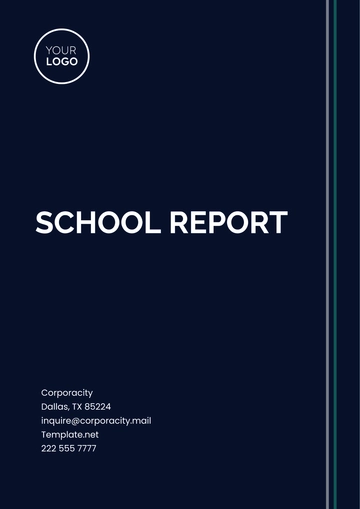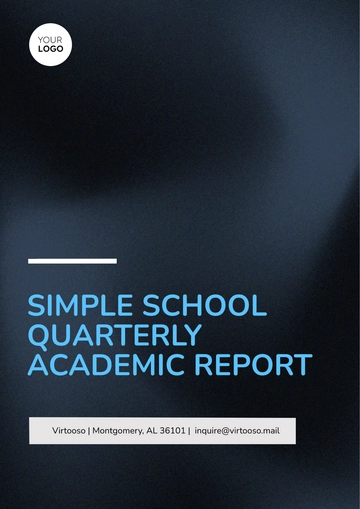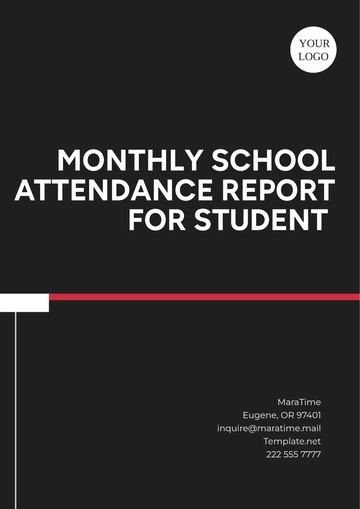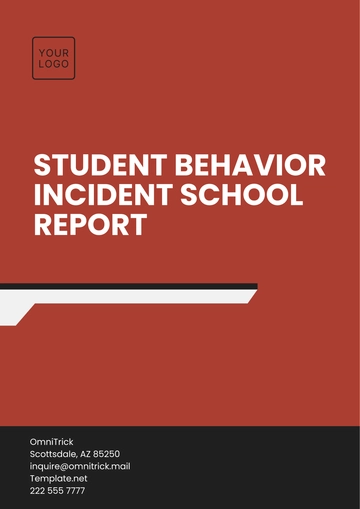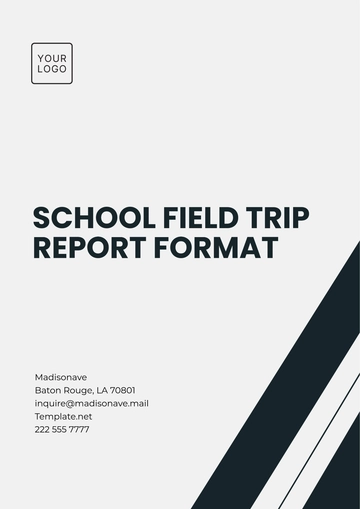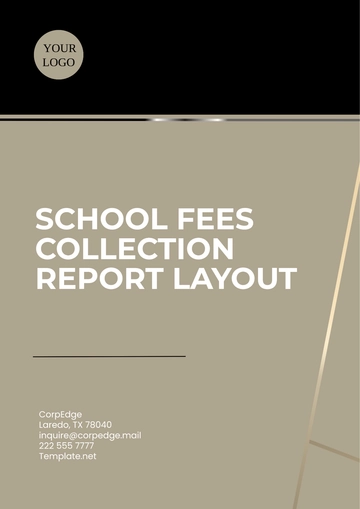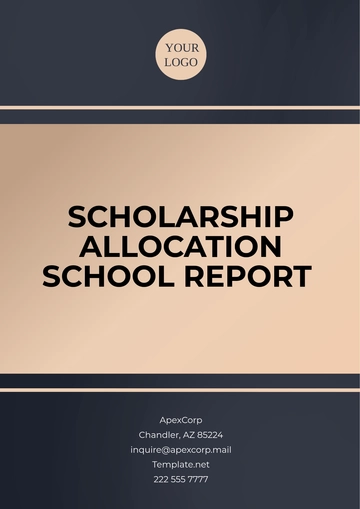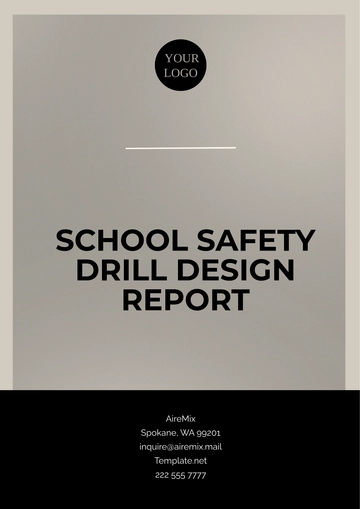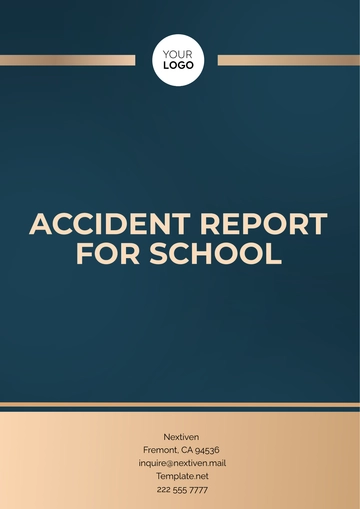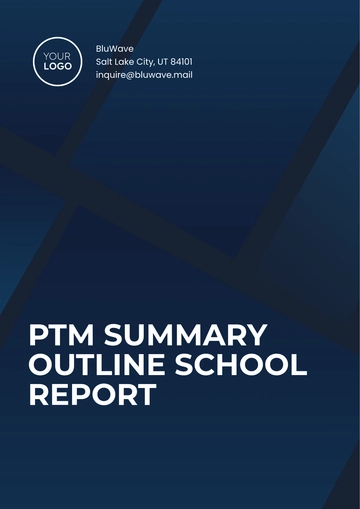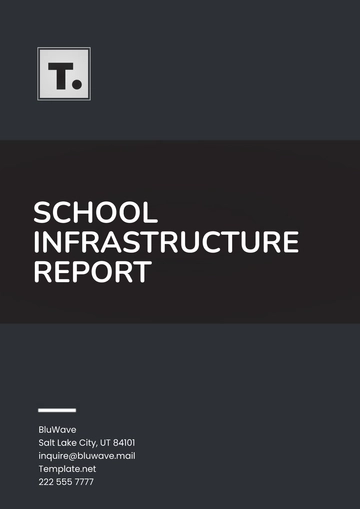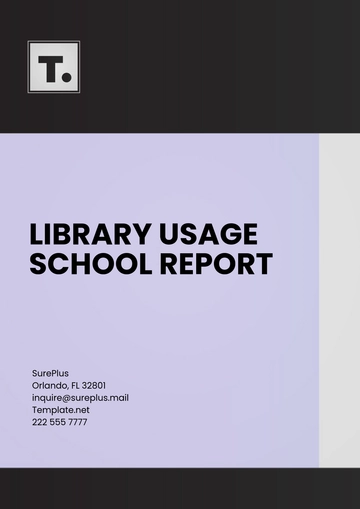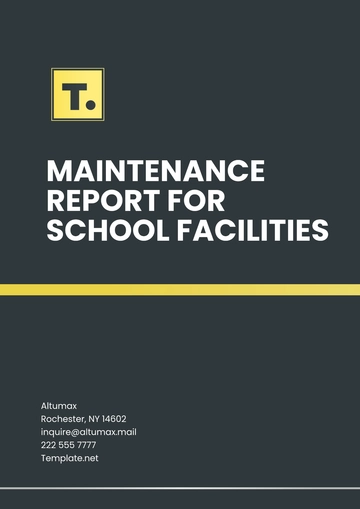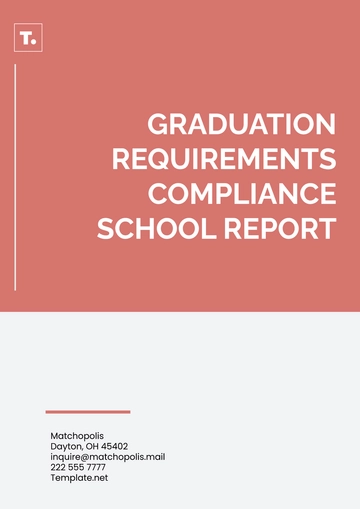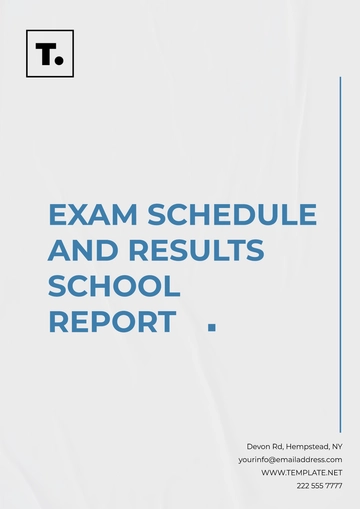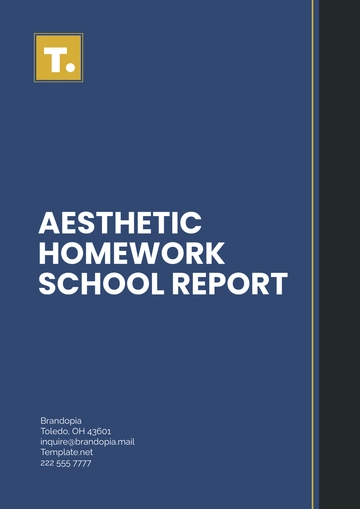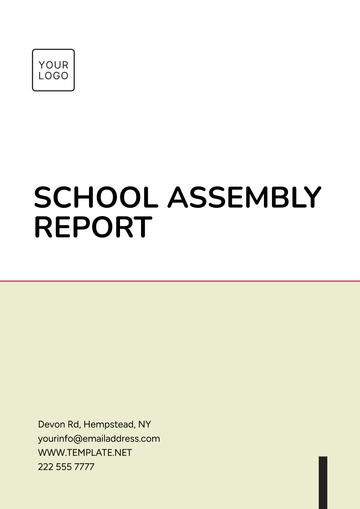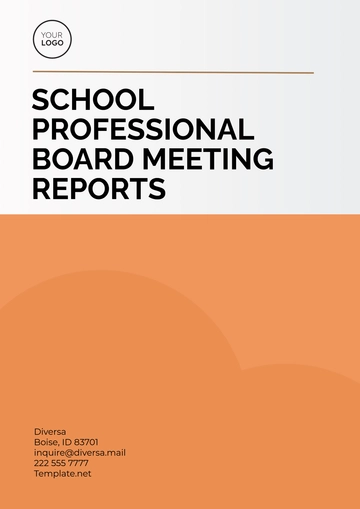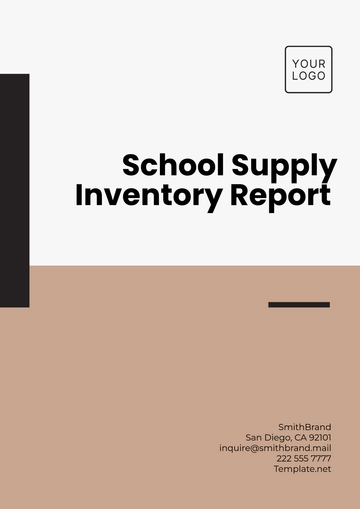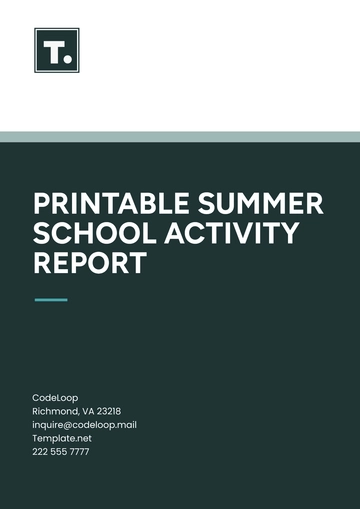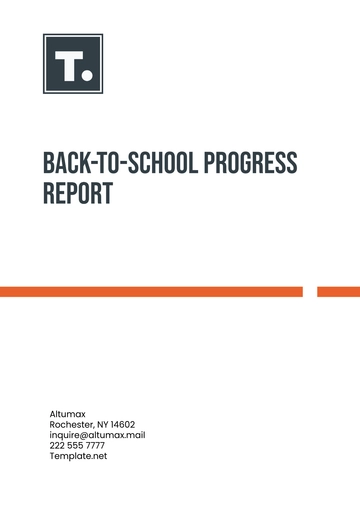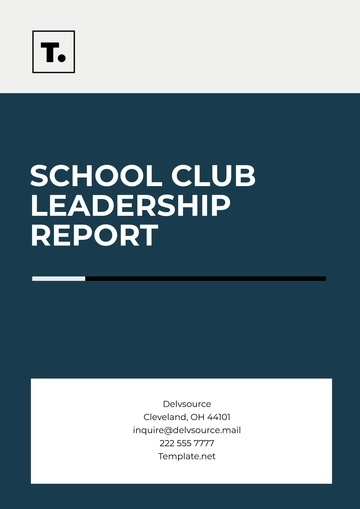Free School Discipline Report
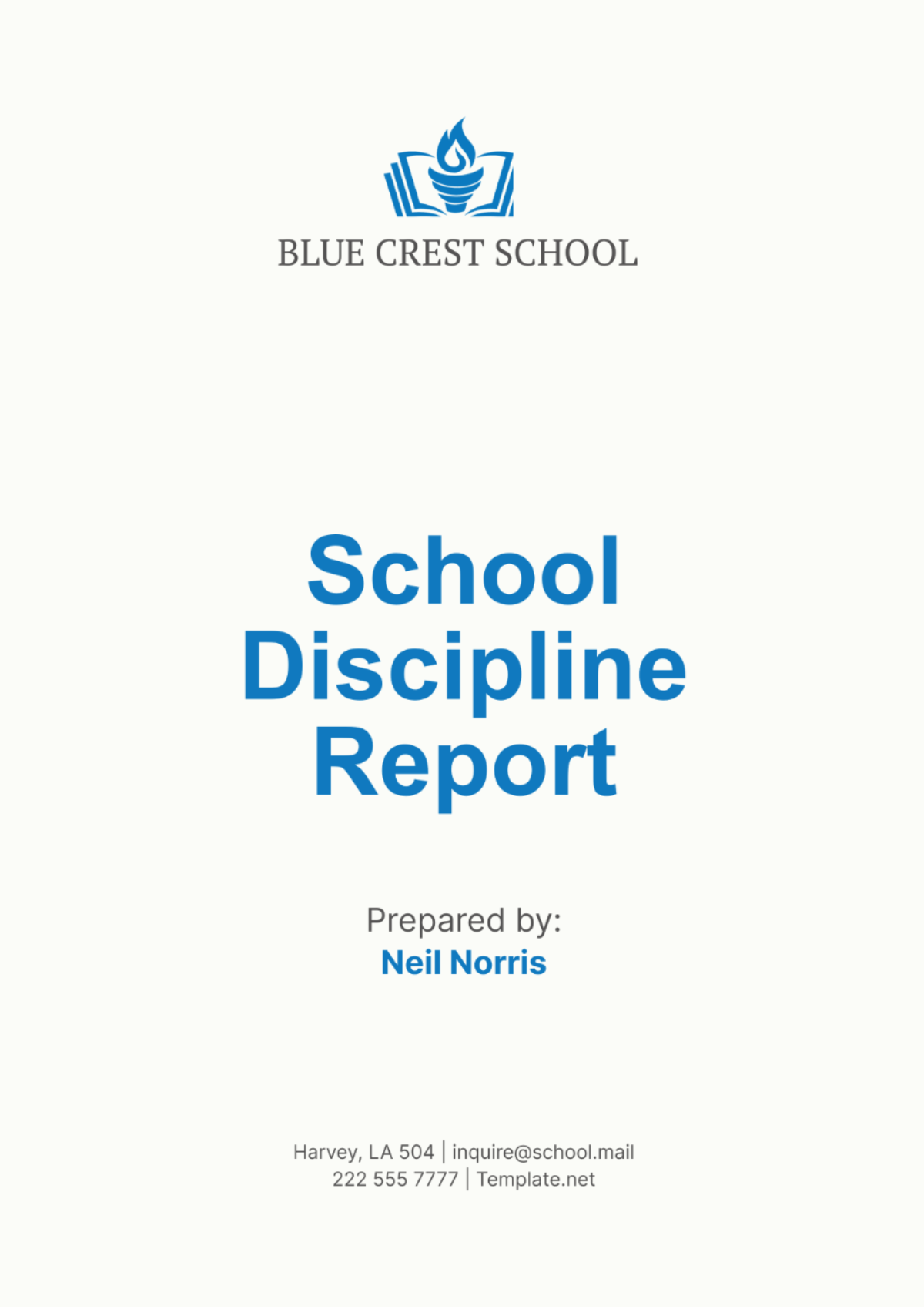
I. Introduction
A. Purpose of the Report
The purpose of this discipline report is to provide a comprehensive analysis of the disciplinary incidents and policies at [Your Company Name]. It aims to evaluate the effectiveness of the current discipline policies, identify trends and patterns in disciplinary incidents, and recommend improvements to enhance the overall school environment. This report seeks to ensure that the school’s discipline policies align with its mission to foster a safe, respectful, and conducive learning environment.
B. Scope of the Report
This report covers all disciplinary incidents and activities that occurred during the [20xx-20xx] academic year. It includes an analysis of various types of misconduct, such as academic dishonesty, behavioral issues, bullying, harassment, and substance abuse. The report also examines the demographic distribution of incidents and assesses the responses and outcomes of notable cases.
C. Methodology
Data for this report was collected through multiple methods to ensure a comprehensive analysis. Incident reports submitted by teachers and staff were reviewed, and surveys were conducted with students, teachers, and parents to gather feedback on the effectiveness of current discipline policies. Additionally, interviews with key personnel involved in policy enforcement provided qualitative insights. The data was analyzed using statistical techniques to identify trends and patterns, and case studies were used to illustrate significant incidents and their handling.
II. Overview of School Discipline Policies
A. Current Discipline Policies
At [Your Company Name], the discipline policies are designed to maintain order and promote a positive school climate. These policies outline the expectations for student behavior and the procedures for addressing violations. Key policies include the Student Code of Conduct, Anti-Bullying Policy, Substance Abuse Policy, and Academic Integrity Policy. Each policy clearly defines unacceptable behaviors and the corresponding consequences.
B. Policy Objectives
The primary objectives of the discipline policies are to create a safe and supportive learning environment, promote respect and responsibility among students, and deter misconduct. These policies aim to ensure that all students can learn without disruption and feel safe from bullying and harassment. By promoting a culture of accountability, the policies also strive to prepare students for responsible citizenship.
C. Policy Implementation
Discipline policies at [Your Company Name] are communicated to students and parents at the beginning of each school year through the Student Handbook and parent orientation sessions. Teachers and staff receive training on policy enforcement and conflict resolution. Regular workshops and refresher courses are provided to keep staff updated on best practices. The school also utilizes an online reporting system to streamline the documentation and tracking of incidents.
III. Analysis of Disciplinary Incidents
A. Incident Statistics
The following table provides a summary of the disciplinary incidents reported during the [20xx-20xx] academic year:
Type of Incident | Number of Incidents | Percentage of Total Incidents |
|---|---|---|
Academic Misconduct | 45 | 22% |
Behavioral Issues | 78 | 38% |
Bullying and Harassment | 50 | 24% |
Substance Abuse | 30 | 16% |
A total of 203 incidents were reported, with behavioral issues being the most common, followed by bullying and harassment, academic misconduct, and substance abuse.
B. Breakdown by Categories
Academic Misconduct
Academic misconduct includes cheating on exams, plagiarism, and unauthorized collaboration. These incidents are typically identified through teacher observations and the use of plagiarism detection software. Consequences for academic misconduct range from detention to suspension, depending on the severity of the offense.
Behavioral Issues
Behavioral issues encompass a wide range of infractions, including disruptive behavior in class, insubordination, and vandalism. These incidents are addressed through a progressive discipline approach, starting with warnings and escalating to more severe consequences for repeated offenses.
Bullying and Harassment
Bullying and harassment incidents are a significant concern at [Your Company Name]. These incidents are reported through anonymous tips, teacher observations, and student reports. The school’s Anti-Bullying Policy mandates immediate investigation and appropriate disciplinary action, including counseling and mediation for the involved parties.
Substance Abuse
Substance abuse incidents involve the possession, use, or distribution of drugs and alcohol. These cases are handled with a combination of disciplinary actions and support services, such as counseling and substance abuse education programs. The school collaborates with local law enforcement when necessary to ensure a safe environment.
IV. Case Studies
A. Notable Incidents
Case Study 1: Academic Misconduct
A group of students in the 10th grade was caught sharing answers during a midterm exam. The incident was detected by the teacher and confirmed through a review of surveillance footage. The students involved received suspensions and were required to complete an academic integrity workshop.
Case Study 2: Bullying and Harassment
A 7th-grade student reported being bullied by a group of peers through social media. The school’s investigation confirmed the allegations, and the bullies received suspensions. The victim was provided with counseling, and the school conducted anti-bullying workshops for all students to raise awareness.
Case Study 3: Substance Abuse
A high school senior was found in possession of marijuana on school grounds. The incident was reported to local law enforcement, and the student was suspended pending further investigation. The student was also referred to a substance abuse counselor and participated in a drug education program.
B. Responses and Outcomes
The school’s response to these incidents was swift and in accordance with established policies. The consequences imposed were aimed at deterring future misconduct and providing support to affected students. The outcomes of these cases highlighted the importance of clear policies and prompt action in maintaining a safe school environment.
C. Lessons Learned
From these case studies, several lessons were learned. Firstly, the importance of vigilance and proactive measures in identifying and addressing misconduct was underscored. Secondly, the need for ongoing education and awareness programs was highlighted, particularly in areas such as bullying and substance abuse. Finally, the value of providing support services to both offenders and victims was recognized, emphasizing a balanced approach to discipline.
V. Effectiveness of Discipline Policies
A. Evaluation Metrics
The effectiveness of the discipline policies at [Your Company Name] was evaluated using several key metrics:
Reduction in Repeat Offenses: The number of students who reoffended after initial disciplinary action.
Student and Staff Feedback: Surveys and interviews assessing perceptions of policy effectiveness.
Incident Resolution Time: The average time taken to resolve disciplinary incidents.
Impact on School Climate: Measures of school climate, including student and staff safety perceptions.
B. Student and Staff Feedback
Feedback from students and staff indicated general satisfaction with the discipline policies. Many appreciated the clear guidelines and consistent enforcement. However, some concerns were raised about the perceived harshness of certain punishments and the need for more preventive measures. The following table summarizes the feedback:
Feedback Category | Positive (%) | Negative (%) | Neutral (%) |
|---|---|---|---|
Clarity of Policies | 80% | 10% | 10% |
Consistency of Enforcement | 75% | 15% | 10% |
Fairness of Consequences | 70% | 20% | 10% |
Availability of Support Services | 65% | 25% | 10% |
C. Impact on School Environment
The discipline policies had a notable impact on the school environment. Students reported feeling safer and more supported, and incidents of severe misconduct decreased. The emphasis on counseling and support services helped create a more compassionate and rehabilitative approach to discipline, contributing to a positive school climate.
VI. Recommendations for Improvement
A. Policy Revisions
To address identified weaknesses, it is recommended to revise certain policies to ensure they are more balanced and inclusive. For instance, the consequences for minor infractions could be adjusted to be less punitive and more focused on corrective measures. Additionally, policies should be regularly reviewed and updated to reflect the changing needs of the student population.
B. Enhanced Training and Support
Providing additional training for staff on conflict resolution and positive behavior interventions can improve the effectiveness of discipline policies. Workshops on cultural competency and inclusivity can help staff better understand and address the diverse needs of students. Increasing the availability of support services, such as counseling and mentoring programs, can provide students with the necessary resources to improve their behavior.
C. Preventive Measures
Implementing more preventive measures can reduce the occurrence of disciplinary incidents. Programs that promote social-emotional learning, peer mediation, and restorative practices can help students develop better conflict resolution skills. Regular workshops and assemblies on topics such as bullying prevention, substance abuse awareness, and digital citizenship can raise awareness and prevent issues before they escalate.
VII. Conclusion
A. Summary of Findings
The analysis of discipline policies and incidents at [Your Company Name] revealed several key findings. The current policies are effective in maintaining order and promoting a positive school climate, but there is room for improvement in terms of resource allocation, inclusivity, and preventive measures. The feedback from students and staff indicated general satisfaction with the policies but highlighted areas where adjustments are needed to better address the needs of the school community.
B. Future Directions
Moving forward, it is crucial to continue monitoring and evaluating the effectiveness of discipline policies. Regular reviews and updates to the policies will ensure they remain relevant and effective. Investing in staff training and support services, as well as implementing preventive programs, will contribute to a more comprehensive and balanced approach to discipline.
C. Final Remarks
Effective discipline management is essential for fostering a safe and conducive learning environment. By continuously improving and adapting discipline policies, [Your Company Name] can ensure that all students have the opportunity to learn and grow in a supportive setting. The commitment to creating a positive school climate will benefit the entire school community and prepare students for responsible citizenship.
- 100% Customizable, free editor
- Access 1 Million+ Templates, photo’s & graphics
- Download or share as a template
- Click and replace photos, graphics, text, backgrounds
- Resize, crop, AI write & more
- Access advanced editor
Document student behavior incidents accurately with Template.net's customizable and editable School Discipline Report Template. Use the AI Editor Tool to customize the report to fit your school's needs. Ensure consistent and thorough discipline reporting with this easy-to-use template.
You may also like
- Sales Report
- Daily Report
- Project Report
- Business Report
- Weekly Report
- Incident Report
- Annual Report
- Report Layout
- Report Design
- Progress Report
- Marketing Report
- Company Report
- Monthly Report
- Audit Report
- Status Report
- School Report
- Reports Hr
- Management Report
- Project Status Report
- Handover Report
- Health And Safety Report
- Restaurant Report
- Construction Report
- Research Report
- Evaluation Report
- Investigation Report
- Employee Report
- Advertising Report
- Weekly Status Report
- Project Management Report
- Finance Report
- Service Report
- Technical Report
- Meeting Report
- Quarterly Report
- Inspection Report
- Medical Report
- Test Report
- Summary Report
- Inventory Report
- Valuation Report
- Operations Report
- Payroll Report
- Training Report
- Job Report
- Case Report
- Performance Report
- Board Report
- Internal Audit Report
- Student Report
- Monthly Management Report
- Small Business Report
- Accident Report
- Call Center Report
- Activity Report
- IT and Software Report
- Internship Report
- Visit Report
- Product Report
- Book Report
- Property Report
- Recruitment Report
- University Report
- Event Report
- SEO Report
- Conference Report
- Narrative Report
- Nursing Home Report
- Preschool Report
- Call Report
- Customer Report
- Employee Incident Report
- Accomplishment Report
- Social Media Report
- Work From Home Report
- Security Report
- Damage Report
- Quality Report
- Internal Report
- Nurse Report
- Real Estate Report
- Hotel Report
- Equipment Report
- Credit Report
- Field Report
- Non Profit Report
- Maintenance Report
- News Report
- Survey Report
- Executive Report
- Law Firm Report
- Advertising Agency Report
- Interior Design Report
- Travel Agency Report
- Stock Report
- Salon Report
- Bug Report
- Workplace Report
- Action Report
- Investor Report
- Cleaning Services Report
- Consulting Report
- Freelancer Report
- Site Visit Report
- Trip Report
- Classroom Observation Report
- Vehicle Report
- Final Report
- Software Report
